Provided that the Guardian Council’s decision stands and former president Hashemi Rafsanjani is not permitted to run for president in the June 14 election, who are the eight remaining candidates from which Iranian voters will choose? ![]()
Despite the rejection of the candidacies of both Rafsanjani, the current chairman of the Expediency Discernment Council, and Esfandiar Rahim Mashaei, chief of staff to incumbent president Mahmoud Ahmadinejad, the Guardian Council approved eight candidates that include both conservatives and liberals, including two figures who were part of the administration of reformist president Mohammad Khatami.
So if Rafsanjani and his supporters ultimately accept the outcome, the race won’t necessarily lack for drama or intensity. With eight candidates in the race, at least initially, the election could well go to a runoff on June 21 if no candidate wins over 50% of the vote, though there’s reason to believe some of the candidates will fall aside as conservatives in particular unite around one or two candidates.
Without further ado, here’s a look at each of the eight approved candidates and their chances to become Iran’s next president.
The Reformists / Moderates
To be sure, Rafsanjani’s disqualification makes the chances of the election of a moderate president more unlikely. In light of the fact that Khatami himself declined to register as a presidential candidate, it means that Iran’s former moderate president and Iran’s former reformist president will both be sitting on the sidelines of the election. The three remaining candidates in the race lack the popularity or political profile that either Rafsanjani or Khatami would have brought to the race, though if both the moderate and liberal camps unite behind one candidate, that candidate could pose a serious challenge.
Mohammad Reza Aref (right). The most pro-reform candidate of the eight, Aref served as vice president during Khatami’s second term after serving as Khatami’s communications minister. An electrical engineer by training and a professor prior to his entry into politics, he was the chancellor of the University of Tehran from 1994 to 1997. Today, he’s currently a member of the Expediency Discernment Council, the 34-member body of officials chaired by Rafsanjani that works to align the Iranian parliament and the Guardian Council. He doesn’t rate as highly as Khatami in terms of charisma, but then again, neither did Mir-Hossain Mousavi in the 2009 presidential election despite the passionate support he engendered in the 2009 election.
With Rafsanjani out of the race, Aref’s chances of becoming president are much higher, but it’s not clear that reformists will necessarily unite around him. Even if Khatami supports him, he may well split the moderate vote with Hassan Rowhani.
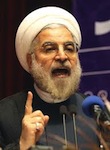 Hassan Rowhani (left). The director of the Strategic Research Center of the Expediency Discernment Council and a member of the Assembly of Experts, Rowhani is the closest Rafsanjani intimate in the race, and Rafsanjani could well back him for the presidency. He was Rafsanjani’s deputy in the Iranian parliament, the Islamic Consultative Assembly (Majles), during the 1980s and from 1992 to 2000, Rowhani served as the parliament’s deputy speaker.
Hassan Rowhani (left). The director of the Strategic Research Center of the Expediency Discernment Council and a member of the Assembly of Experts, Rowhani is the closest Rafsanjani intimate in the race, and Rafsanjani could well back him for the presidency. He was Rafsanjani’s deputy in the Iranian parliament, the Islamic Consultative Assembly (Majles), during the 1980s and from 1992 to 2000, Rowhani served as the parliament’s deputy speaker.
From 1989 to 2005, he was the secretary of the Supreme National Security Council, a position now held by his more conservative rival for the presidency, Saeed Jalili. From 2003 to 2005, he was Iran’s chief nuclear negotiator with the United Kingdom, Germany and France, and under his lead, Iran agreed to a short-lived deal to suspend its uranium enrichment. Although he’s far from a ‘Green movement’ partisan, he’s been a critic of Ahmadinejad in the past, especially with respect to the Ahmadinejad administration’s handling of the Iranian economy.

Although all candidates in the presidential election are likely to champion Iran’s nuclear energy program, Rowhani (like Rafsanjani) would likely try to improve relations with the United States and Europe as president. A centrist more than a reformist, he’s close enough to Supreme Leader Ali Khamenei and the Supreme Leader’s allies that liberal reformers may be less than enthusiastic to back Rowhani.
Mohammad Gharazi (right). The least well-known of the moderate candidates for the presidency, Gharazi served as Iran’s oil minister from 1981 to 1985 and later as communications minister from 1985 to 1997.
He’s likely to play a minor role in the campaign, however, with Rowhani and Aref poised to take the lion’s share of former Rafsanjani supporters. At age 71, he’s the oldest candidate in the race, but still two years younger than Khamenei and seven years younger than Rafsanjani.
The 2+1 Principlist Coalition
Prior to the registration period, three potential candidates — Tehran mayor Mohammad Baqer Qalibaf, former parliamentary speaker Gholam Ali Haddad-Adel and top Supreme Leader adviser Ali Akbar Velayati — formed the ‘2+1 Principlist’ coalition. Generally speaking, however, all five of the conservatives in the race could be said to be ‘principlists,’ in that they would all defer to Khamenei’s ultimate authority as Supreme Leader. The idea behind the ‘2+1’ coalition is that the three candidates will eventually band together in support of one candidate. Although that candidate would likely be one of the three members of the 2+1 Principlist coalition, Velayati himself suggested on Sunday that all three could eventually drop out in favor of yet another conservative, nuclear negotiator Saeed Jalili. Either way, expect at least two of the following candidates to withdraw between now and June 14. For now, however, the three candidates will go forward.
Mohammad Baqer Qalibaf (right). 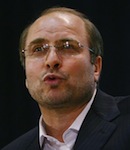 Qalibaf was elected mayor of Tehran in 2005, following six years as head of the national police forces. A former presidential candidate in 2005, he finished in fourth place with nearly 14% of the vote, behind Rafsanjani, Ahmadinejad and reformist candidate Mehdi Karroubi. He was seen as a potential challenger to Ahmadinejad in the 2009 election and, though he decided not to run in 2009, he’s among the more well-known and popular of the eight candidates. Despite his rivalry with Ahmadinejad, he’s still very conservative. A member of the Revolutionary Guard in the 1980s during the war with Iraq, Qalibaf has played a key role in suppressing the student protests in 1999 and in 2003. As the head of the national police forces, however, he initiated several reforms, including the development of the equivalent of a ‘911’ emergency number system for Iran (the ‘110’ number).
Qalibaf was elected mayor of Tehran in 2005, following six years as head of the national police forces. A former presidential candidate in 2005, he finished in fourth place with nearly 14% of the vote, behind Rafsanjani, Ahmadinejad and reformist candidate Mehdi Karroubi. He was seen as a potential challenger to Ahmadinejad in the 2009 election and, though he decided not to run in 2009, he’s among the more well-known and popular of the eight candidates. Despite his rivalry with Ahmadinejad, he’s still very conservative. A member of the Revolutionary Guard in the 1980s during the war with Iraq, Qalibaf has played a key role in suppressing the student protests in 1999 and in 2003. As the head of the national police forces, however, he initiated several reforms, including the development of the equivalent of a ‘911’ emergency number system for Iran (the ‘110’ number).
He has achieved recognition for his stewardship of Tehran, and he was named the world’s eighth-best mayor in 2008 for his ‘modernisation of the capital’s infrastructure and public services,’ though the world’s enthusiasm receded after he played a key role in suppressing the post-election demonstrations in 2009. A longtime rival to Ahmadinejad, he has successfully fought to dominate Ahmadinejad’s rivals in the Tehran city council.
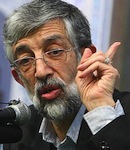
Gholam Ali Haddad-Adel (left). Iran’s parliament speaker from 2004 to 2008 and the current chair of its culture committee, though he lost the race for speaker following the 2012 elections to Ali Larijani.
Haddad-Adel’s daughter is married to Khamenei’s son Motjaba Khamenei, and he’s perhaps one of the two closest Khamenei confidants in the race. It’s especially relevant given Motjaba Khamenei’s own designs to follow in the footsteps of his father as Supreme Leader one day, despite the fact that he has even fewer religious credentials than his father.
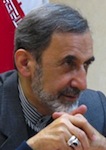
Haddad-Adel is also a member of the Expediency Discernment Council.
Ali Akbar Velayati (right). A top advisor to the Supreme Leader on international affairs and Iran’s foreign minister from 1981 to 1997 during both Khamenei’s presidency and Rafsanjani’s presidency, Velayati is a key behind-the-scenes player in Iran’s foreign affairs and diplomacy. He supports the current hardline stance against the West, generally, and the United States, in particular, and he has sometimes served as an envoy of the Supreme Leader abroad, undermining the foreign policy of the Ahmadinejad administration.
Also a member of the Expediency Discernment Council, Velayati was Khamenei’s original choice for the office of prime minister in 1981, though the Iranian parliament blocked his appointment, paving the way for Mousavi to become prime minister. Velayati, as noted above, has implied as recently as Sunday that he’ll eventually endorse Jalili.
The Remaining Conservatives
The two remaining candidates in the race, Saeed Jalili and Mohsen Rezai, are not part of the formal ‘2+1 Principlist’ coalition as such, but they remain principlists nonetheless. What’s striking is that Mashaei’s rejection leaves no Ahmadinejad supporters left in the presidential race, though Jalili is perhaps the closest of the eight conservatives to the Ahmadinejad camp. That means that not only will Ahmadinejad find himself without a champion during the campaign, but he’ll find himself increasingly sidelined during the campaign and isolated when his term ends.
Saeed Jalili (right). 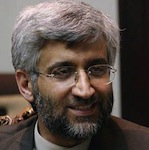 The man who seems mostly likely to emerge as the likeliest champion of Iranian conservatives is Jalili, who’s been the secretary of Iran’s Supreme National Security Council since 2007 and, more importantly, the current chief negotiator on Iran’s nuclear energy program with the six major powers — the United States, Russia, China, the United Kingdom, France and Germany. That means he has the backing of the Supreme Leader on the most complex foreign policy issue facing Iran today.
The man who seems mostly likely to emerge as the likeliest champion of Iranian conservatives is Jalili, who’s been the secretary of Iran’s Supreme National Security Council since 2007 and, more importantly, the current chief negotiator on Iran’s nuclear energy program with the six major powers — the United States, Russia, China, the United Kingdom, France and Germany. That means he has the backing of the Supreme Leader on the most complex foreign policy issue facing Iran today.
Jalili, though a conservative, served as a deputy foreign minister in charge of European and U.S. relations during Khatami’s second term in the early 2000s. Born in 1965, he’s 47 years old, making him the youngest of the eight candidates as well. Like Qalibaf, he came of age during the horrific war with Iraq, and as a member of the Revolutionary Guard, Jalili lost part of his right leg and saw some of the heaviest fighting of the 1980s. That experience is said to be at the heart of his current worldview by international observers who have negotiated with him in the past.
A rising star during the Ahmadinejad administration, he’s seen as a candidate who could restore unity between Ahmadinejad’s conservative backers and the dominant principlists that have supported Khamenei in the Supreme Leader’s power struggles against Ahmadinejad. No one knows whether the incumbent will try to insert himself into the narrative of the race with an endorsement or other antics, but Jalili would likely welcome Ahmadinejad’s quiet endorsement. On Monday alone, the president’s brother (and one of the president’s harshest critics) Davood Ahmadinejad, and former health minister Bagheri Lankarani both dropped out of the presidential race in favor of Jalili.
Mohsen Rezai (left). 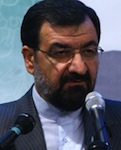 Rezai is the secretary-general of the Expediency Discernment Council and the former chief of the Revolutionary Guard from 1981 to 1997. He ran for president in 2005, though he eventually withdrew, and he challenged Ahmadinejad from the conservative right in 2009, though he won just 1.73% of the vote.
Rezai is the secretary-general of the Expediency Discernment Council and the former chief of the Revolutionary Guard from 1981 to 1997. He ran for president in 2005, though he eventually withdrew, and he challenged Ahmadinejad from the conservative right in 2009, though he won just 1.73% of the vote.
He’s somewhat of a conservative reformist, in many ways, and he may well receive solid support from the military and security forces within Iran, though that’s hardly enough of a base to win the presidency, and he’s a longshot to win.
Though he’s hardly a ‘Green movement’ partisan, but he initially joined Mousavi and Karroubi in questioning the final results.
Top photo credit to Roshan Norouzi/ZUMA Press.

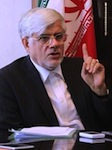
5 thoughts on “A look at the eight presidential candidates approved by Iran’s Guardian Council”